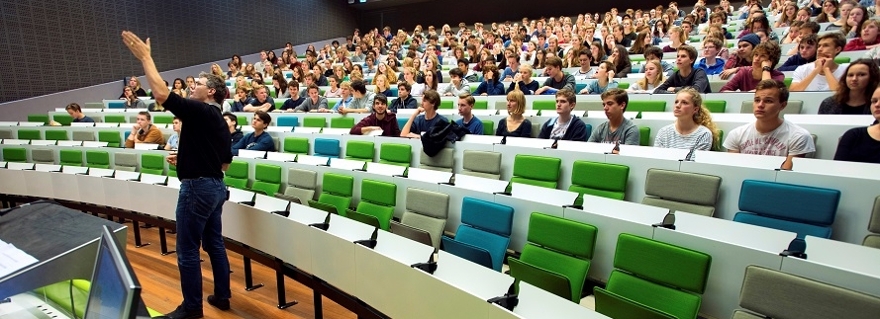
Education Blog Archaeology: Alex Geurds on recording lectures
In this series the Vice-Dean and portfolio holder of education in the board of the Faculty of Archaeology will reflect on the state of education. Posts can range from shedding light on current national shifts in the university landscape to arguments as to why it’s important to be timely with designing your classes. Some blogs will be aspirational, others will be more informative, or indeed also inviting. The opinions found here are personal but will also not be disconnected from Faculty Board policymaking.

Should we keep recording lectures?
Even though they were already around for years, lecture recordings were a rarity at our Faculty up until five years ago. The arrival of COVID-19 transformed lecture recordings, infamously almost overnight, into a fundamental method of teaching. Swivelling cameras and countless recordings linked to Brightspace became essential if we still wanted to have university teaching at all. We all started speaking to our computer at home for hours on end – it was weird.
Today, most of our Bachelor courses have maintained recording availability even though, luckily, the depressing lockdown days are over (for now). But what we see is that it’s become something that many students expect. One could say that lecture recordings now are an integral part of their undergraduate learning experience. But not everyone agrees with this. Lecturers are sometimes not thrilled when attendance drops visibly a couple of weeks into their course. Moreover, research into learning practices sees a positive correlation between recordings and learning, but when used as supplements. They also argue that recordings cannot replace active participation and may impact the way in which students learn. Let’s see what’s going on.
The positive
Having recordings available is in part about flexibility. The ability to watch recordings later helps students who are having to juggle a job and is a fitting way to break up what may be a longer train commute home. You might also be facing a big deadline and then it’s nice to be able to skip a class and watch the recording when it fits your scheduling.
Research indicates that students use recordings to review complicated content and to complete missing class material and to study for tests. The technology also benefits students who are non-native speakers as well as those with special needs. The recording feature provides essential help to students who have hearing disabilities or chronic illnesses or mobility issues. Studies also show that students who use recordings for such self-paced learning may experience reduced anxiety. The recording feature functions as an effective learning tool because it enables students to stop the lecture and review challenging information at their preferred pace. This all feeds into the idea to keep recording lectures.
The negative
It’s probably generally agreed that a dropping attendance rate across a series of classes is not desirable. And recordings do play into this phenomenon. Also there, though, higher education learning research tends to show that the issue has more far-reaching consequences, in leading to the disappearance of social learning opportunities. In other words, learning improves if you do it together and vocally. Research indicates that students who depend only on recordings tend to show lower engagement while their performance suffers in certain situations when they substitute attendance with passive viewing.
The argument here is that academic success depends on social learning opportunities with spontaneous discussions and immediate feedback which can only occur during in-person classes. Students achieve the best results when they use recordings as a supplement to in-person teaching because this combination provides review flexibility while retaining the active collective learning benefits. It also promotes deep rather than surface learning, that is, a focus on creating understanding rather than memorising facts.
Students who attend lectures together experience more than content delivery because they exchange reactions and ask impromptu questions and continue their discussions before and after class. The collective engagement between students enables them to understand material better. Not insignificantly either, one learns to feel part of a learning group, something hard to replicate when you are facing your laptop in your room.
Lastly, there is always the added question of sharing unedited research material, but this is also generally a concern, for example, with slide decks and discussing possibly quarantined or unpublished research data. For us, this is perhaps something largely restricted to the colleagues working on human origins though.
Finding the Balance
I think we can do better with creating classroom activities that are effective for reaching learning objectives but do not translate well in a recording. Our lab-based classes are one example thereof – show and tell is still a very powerful method. And dialogue may be the single most effective tool for active learning. The challenge there is how to find ways to dialogue with large groups, but this can be done. And lastly, the BA1 is not the same as the BA3. Clearly there’s an argument for more unidirectional information flow in the first year than in the second and third year.
Trusting Students
Students are adult learners. In that sense I don’t think it’s productive to impose mandatory attendance, even if colleagues have that measure at their disposal. Students should have the right to choose their approach to course engagement provided they fulfil the established learning objectives. They should also be aware that classroom attendance offers advantages that cannot be replaced by recordings alone, including collective energy and live discussions and stronger academic relationships.
Much of this is also linked to the challenge of creating active learning with large groups and the way exams are set up for many of the Bachelor classes. But that is for another blog.
Exchange ideas with Alex Geurds
Would you like to exchange ideas with Alex Geurds? Please send him an email or walk by his office (A2.07).
